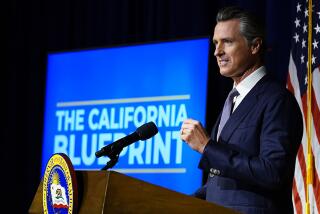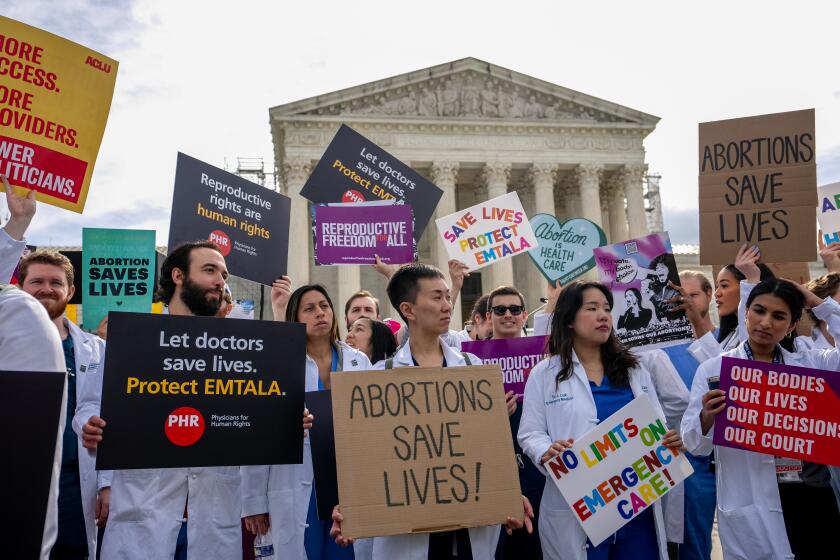Editorial: The California Legislature has loads of good ideas that the state probably can’t afford
California is heading into the new fiscal year in unexpectedly good shape, with roughly $8 billion extra in its coffers. Yet state lawmakers are actually showing a degree of fiscal restraint. After filling the state’s rainy-day reserve fund to its constitutional limit — 10% of the state’s general fund — the Assembly’s budget writers are proposing to spend $4 billion on new initiatives, and the Senate $2.9 billion.
But as the two chambers negotiate a compromise proposal to take to Gov. Jerry Brown, they need to keep an eye first and foremost on the sustainability of any commitments they make. Not only is the state budget being lifted by an influx of volatile capital gains tax revenue that may not recur, but many of the proposals they’re advancing would be considerably more expensive in later years than they would be today.
Brown helped pull the state out of a years-long budget crisis, persuading voters to approve a tax increase in 2012 (which was renewed in part in 2016) and limiting new spending to one-time needs and programs that could be easily unwound in the event of a downturn. This combination of new tax dollars, disciplined spending and a steadily growing economy has led state revenue to exceed projections for several years in a row, while also building up the state’s new rainy-day fund faster than anticipated.
Which brings us to where we are now, with the Senate and Assembly budget committees meeting to settle on a unified spending plan for the fiscal year that begins July 1. Brown, who is in the final year of his final term, has proposed spending $137.5 billion from the General Fund, while the Senate and Assembly — both of which assume the state will collect more in taxes than Brown projects — want to spend roughly $2 billion to $3 billion more, respectively.
Their proposals include badly needed one-time boosts in funding for affordable housing, mental health programs and aid to homeless Californians. Similar one-time outlays to shore up the state’s pension funds and unemployment-insurance reserves would also be welcome.
Much of what lawmakers are suggesting, however, involves ongoing obligations. Some of those would be phased in over time and would be relatively easy to backtrack from, such as a much-needed increase in CalWORKs grants to help poor state residents move from welfare to work. And some, arguably, are fundamental to long-term economic growth and the battle against poverty, such as the increased funding for subsidized child care and the state’s colleges and universities.
Lawmakers can’t make a commitments without an eye on what would happen if the economy slumps again, which it is bound to do eventually.
Lawmakers in each chamber are also pushing to make health insurance available and affordable to more state residents. These proposals include extending Medi-Cal to low-income immigrants living in the state illegally who are between the ages of 19 and 25, as well as those who are 65 and older. Another idea is to offer state subsidies to citizens with low to moderate incomes to help them afford coverage at the state’s Obamacare marketplace, Covered California.
There are good arguments for all three proposals. Bringing every Californian under the insurance tent will help promote efficient, effective care and help efforts to slow the crippling growth of health costs. And beefing up subsidies in Covered California would help counteract the Trump administration’s deliberately disruptive actions that are driving up premiums while driving out consumers and insurers. Avoiding that outcome would be good for everyone — if more people go uninsured as a result of rising premiums in Covered California, more medical bills would go unpaid, leading doctors and hospitals to pass on more costs to people with insurance.
Yet like the CalWORKs proposal, the healthcare initiatives would cost far more in later years than they would in 2018-2019, jumping from $350 million to more than $1 billion a year by the administration’s estimate. Lawmakers can’t make a commitment like that without an eye on what would happen if the economy slumps again, which it is bound to do eventually.
One idea the Legislative Analyst’s Office floated for CalWORKs is to set aside the dollars saved as the economy improves and the demand for welfare benefits shrinks. That reserve could help cover the rise in costs when the economy swings the other way. Similarly, the Senate has proposed creating an additional rainy-day fund just for safety net programs. These are the sort of fallback measures the state has lacked in the past, and they should be a prerequisite to any move to spend the dollars collected in good years on programs that could cost the state dearly in bad ones.
Follow the Opinion section on Twitter @latimesopinionand Facebook
More to Read
A cure for the common opinion
Get thought-provoking perspectives with our weekly newsletter.
You may occasionally receive promotional content from the Los Angeles Times.






